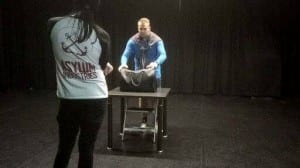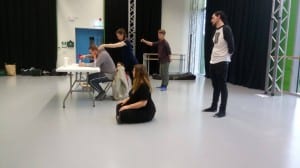‘Orchid’ debuted on 22nd May 2017 in the Lincoln Performing Arts Centre. Since this is a retrospective post, I would like to take this time to discuss the performance and my thoughts on it. In order to get sentimentality out of the way first, may I just say that the show would not have been nearly as engaging or spectacular as I believe it was without the talent I was surrounded with during this process. So, I thank my fellow company members for that. I did, however, already pay them this compliment in my director’s note in the programme, so that is all they will be getting here.
Firstly, the response to the show was overwhelming, with numerous audience members speculating and taking their own unique meanings away with them. Whilst this was indeed what we wanted ‘Orchid’ to achieve, I have always felt that the show is particularly tragic and macabre in nature. So, I was interested to hear some people discuss positivity and relief in relation to it, them seeing the show as taking them through the Cyclist’s grieving process from start to finish. In earlier posts, I have discussed the importance of pacing and the integral part it plays in theatre. In that respect, I believe ‘Orchid’ hit all of its marks. The frantic nature of the madness scenes melded well with the slower and dream-like Interludes. Perhaps the only section that felt jarring was the fight section during the Sadism scene. It had been noted on a few occasions that this section did not quite fit with the rest of the material. Whilst I most certainly see its merit (it intertwined with the uncomfortable feeling and twisted humour of the scene), had we had more time I believe we would have revisited the entire scene, building it from the ground up again to see what we could create. Indeed, we had very recently introduced blindfolds into the section, but this proved somewhat difficult, as it was completely within the audience’s power to remove it at any point. As I said previously, I believe taking the scene back to the workshop and deconstructing it would have been useful for us to do, as we had done with scenes previously. The only other aspect to mention is just to simply sate our curiosity. After the show was over, we instantly began discussing the malleability of ‘Orchid’ as a show. To give a few examples, we spoke about moving the tech box (which had been onstage) directly to the centre, doing the same with the bike, swapping the order of scenes etc. All this would be extremely interesting to try, stretching the limits of the show and testing its boundaries.
My first full-scale foray into directing has been a journey of discovery. In his foreword to Katie Mitchell’s ‘The Director’s Craft: A Handbook for the Theatre’ (2009), Nicholas Hytner describes that young directors are sometimes “given opportunities to discover how clueless they are” (Hytner, 2009). Whilst this may seem self-deprecating to include, I assure you I do not mean it that way, although I do believe it applies to me. My experience directing ‘Orchid’ has been engaging and educational, and I am excited about the possibilities it has opened up. I hope that this experience will allow me to “start to piece together a version of how the theatre actually works” (Hytner, 2009).
Works Cited
Hytner, N. (2009) Foreword in The Director’s Craft: A Handbook for the Theatre. London: Routledge.






